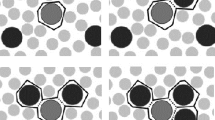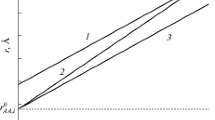Abstract
According to the model of ideal associated solutions, between one and three associates are usually identified in a typical binary metallic solution with negative deviation from Rouault’s law. According to the phase rule, however, the number of simultaneously coexisting associates must not exceed the number of chemical elements present. In other words, there should be no more than two associates. It is assumed that chemical reactions between the associates eliminate the excess. A special function taking this interaction into account is introduced in the system of equations for the model of ideal associated solutions.
Similar content being viewed by others
References
Berdnikov, V.I. and Gudim, Yu.A., Predicting the thermodynamic properties of liquid intermetallide solutions, Steel Transl., 2014, vol. 44, no. 7, pp. 498–501.
Berdnikov, V.I. and Gudim, Yu.A., Identifying associates in liquid binary solutions, Steel Transl., 2014, vol. 44, no. 11, pp. 819–823.
Berdnikov, V.I., Machine calculation of chemical equilibria in multicomponent systems, Izv. Vyssh. Uchebn. Zaved., Chern. Metall., 1984, no. 4, pp. 120–122.
Berdnikov, V.I., Gudim, Yu.A., and Karteleva, M.I., The phase rule in the analysis of metallurgical processes, Steel Transl., 2010, vol. 40, no. 12, pp. 1025–1028.
Berdnikov, V.I. and Gudim, Yu.A., Thermodynamic properties of binary metallic systems containing intermetallic compounds, Steel Transl., 2013, vol. 43, no. 5, pp. 274–277.
Geologicheskii slovar’ (Geological Dictionary), Kshishtofovich, K.N., Ed., Moscow: Nedra, 1955.
Berdnikov, V.I., Gudim, Yu.A., and Karteleva, M.I., Thermodynamic properties of complex oxide systems, Steel Transl., 2011, vol. 41, no. 8, pp. 627–630.
Grigoryan, V.A., Stomakhin, A.Ya., Ponomarenko, A.G., et al., Fizikokhimicheske raschety elektrostaleplavil’nykh protsessov (Physicochemical Calculations of Electrosmelting), Moscow: Metallurgiya, 1989.
Desai, P.D., Thermodynamic properties of binary alumimum alloys, J. Phys. Chem. Ref. Data, 1987, vol. 16, no. 1, pp. 110–124.
Alpatov, A.V. and Paderin, S.N., Calculation of interaction parameters in terms of the mixing energy, http://steelcast.ru/interaction_coefficients_calculation_02, 2011.
HSC Chemistry Database 6, Antti Roine–Pori, Finland: Outokompu Research Oy Information Service, 2006.
Tokunaga, T., Hashima, K., Ohtani, H., and Hasebe, M., Analysis of the Ni–Si–Ti system using thermochemical properties determined from ab initio calculations, Mater. Trans., 2004, vol. 43, no. 5, pp. 1507–1514.
Kulikova, T.V., Il’ninykh, N.I., Moiseev, G.K., and Shunyaev, K.Yu., Thermodynamic properties of solid phases and liquid alloys in the Ni–Al system, Rasplavy, 2007, no. 6, pp. 24–32.
Trusov, B.G., Baza dannykh i programmnyi kompleks Terra (Terra Database and Software), Moscow: MGTU im. N.E. Baumana, 2013.
Batalov, G.I. and Sudavtseva, V.S., Thermodynamic properties of manganese–silicon melts, Izv. Akad. Nauk SSSR, Neorgan. Mater., 1975, vol. 11, no. 10, pp. 1539–1543.
Lee, Y.E., A thermodynamic assessment of liquid Mn-Si alloy, ISIJ Intern., 2012, vol. 52, no. 9, pp. 1539–1543.
Turdogan, E.T., Yrieveson, P., and Beisler, J.F., Kinetic and equilibrium considerations for silicon reaction between silicate melts and graphite-saturated components. Part 1. Reaction equilibrium, Trans. Metallurg. Soc. AIME, 1963, vol. 227, no. 6, pp. 1258–1265.
Moiseev, G.K., Vatolin, N.A., Marshuk, L.A., and Il’inykh, N.I., Temperaturnyi zavisimosti privedennoi energii Gibbsa nekotorykh neorganicheskikh veshchestv (Al’ternativnyi bank dannykh ACTPA.OWN) (Temperature Dependence of the Reduced Gibbs Energy of Some Inorganic Materials: ACTPA.OWN Alternative Databank), Yekaterinburg: UrO RAN, 1997.
Berdnikov, V.I., Gudim, Yu.A., and Karteleva, M.I., Thermodynamic models of complex regular and ideal associated solutions, Steel Transl., 2009, vol. 39, no. 8, pp. 615–620.
Author information
Authors and Affiliations
Corresponding author
Additional information
Original Russian Text © V.I. Berdnikov, Yu.A. Gudim, 2015, published in “Izvestiya VUZ. Chernaya Metallurgiya,” 2015, No. 7, pp. 513–519.
About this article
Cite this article
Berdnikov, V.I., Gudim, Y.A. Correcting the thermodynamic model of ideal associated solutions. Steel Transl. 45, 488–493 (2015). https://doi.org/10.3103/S0967091215070037
Received:
Published:
Issue Date:
DOI: https://doi.org/10.3103/S0967091215070037




